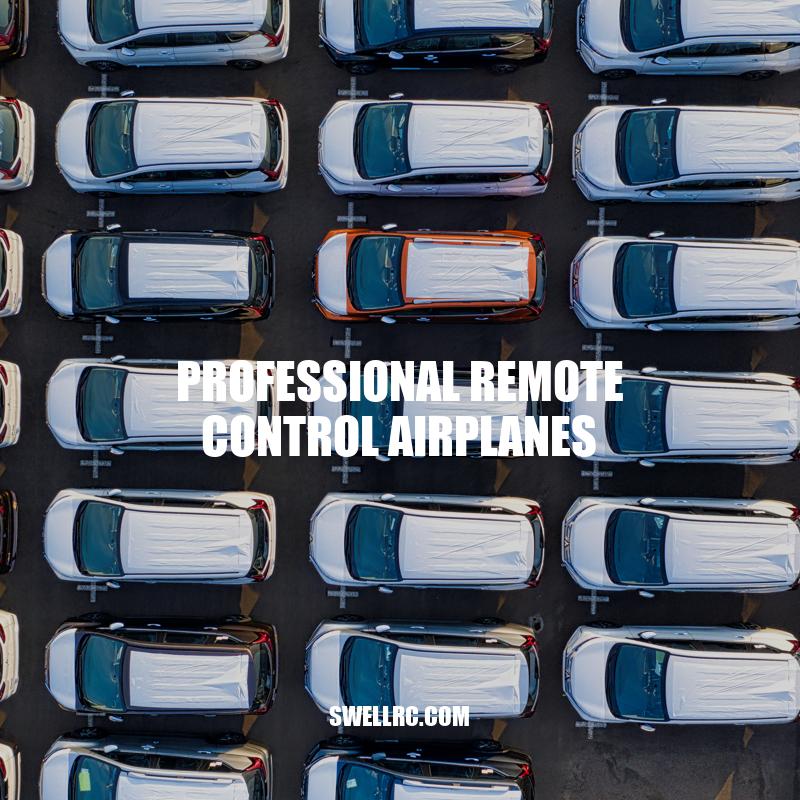Professional Remote Control Airplanes: Precision Flying and Aerobatics
Flying remote control airplanes has been a popular hobby for many decades, offering a thrilling and rewarding experience for enthusiasts of all ages. However, in recent years, professional remote control airplane flying has emerged as a highly specialized field, requiring advanced skill and expertise. Professional remote control airplanes are sophisticated machines that are designed for precision flying techniques and aerobatics, able to execute complex maneuvers both in competition and commercial applications such as search and rescue, crop spraying and a variety of inspection services. As with other professional fields, mastering the art of piloting professional remote control airplanes requires significant dedication, practice, and knowledge in the fields of aerodynamics and electronics. Whether you’re an amateur looking to turn your passion into a professional career or a seasoned pilot interested in expanding your flying experience, understanding the nuances and complexities of professional remote control aviation is essential for success in this exciting and evolving industry. In this article, we’ll delve deeper into the world of professional remote control airplane flying, discussing what it is, how it works, and what you need to know if you’re aspiring to become a professional remote control airplane pilot.
What Are Professional Remote Control Airplanes?
Professional remote control airplanes are advanced drones that are used for precision flying techniques and aerobatics. Unlike hobby-grade drones that are built for fun, professional remote control airplanes are highly specialized machines that require expertise in aerodynamics and electronics.
- Designed for precision flying and aerobatics
- Built with high-quality materials such as carbon fiber
- Equipped with advanced electronics to help the pilot control the aircraft
- Compete in aerobatic competitions and commercial applications such as crop spraying and search and rescue
- Often autonomously flown with GPS coordinates and sensor data
Professional remote control airplanes come in a range of sizes and models, each with specific capabilities and features. Some popular models include the Xoar PJD Goldline, the E-Flite Sukhoi Su-29mm, and the Thunder Tiger Yak 54.
To learn more about the different types of professional remote control airplanes, as well as the equipment and accessories needed to fly them, visit websites such as RCGroups.com, HobbyKing.com, and MotionRC.com. These sites offer a wealth of information on the latest models and technologies, as well as forums where pilots can connect with other enthusiasts and professionals to share tips and advice.
What are remote controlled aircraft called?
Remote controlled aircraft are commonly known as drones. Drones can be used for various purposes such as aerial photography, surveillance, delivery, and recreational purposes. There are many different types and models of drones available in the market, ranging from basic beginner ones to more professional and advanced ones. Some popular drone brands include DJI, Parrot, and Holy Stone. For more information and reviews on various drone models, websites such as dronefly.com and dronedj.com can be helpful resources.
How Do Professional Remote Control Airplanes Work?
Professional remote control airplanes use advanced technology to achieve precision flying techniques, aerobatics, and other specific maneuvers. These aircraft are controlled using radio signals from a pilot’s controller to onboard receivers that interpret the instructions and perform the associated actions. Here’s how professional remote control airplanes work:
- Controlled using a radio transmitter
- Receiver onboard translates signals from the controller into actions such as turning, accelerating, or slowing down
- Pilots control aircraft with a controller
- Advanced electronics interpret inputs to control the aircraft’s functions
- GPS and other sensors on-board for autonomous flying
Professional remote control airplanes have many complex systems onboard that allow them to fly precisely and perform aerobatics. These systems include gyroscopes, accelerometers, and flight controllers, and they are designed to work together to provide the pilot with a smooth and stable flight experience. In addition to these systems, professional remote control airplanes may also have various sensors and cameras onboard to provide additional information to the pilot.
Below is a table that summarizes some of the key features of professional remote control airplanes:
| Feature | Description |
|---|---|
| Advanced electronics | High-tech systems onboard to control the aircraft’s functions |
| GPS navigation | Allows for autonomous flying and precise navigation |
| Sensors and cameras | Provide additional information to the pilot for enhanced flight performance and safety |
| Aerobatic capabilities | Designed to perform complex aerobatics and maneuvers |
| Commercial applications | Used for crop spraying, surveying, and search and rescue missions |
If you’re interested in learning more about the technology behind professional remote control airplanes, visit websites such as RCGroups.com and FliteTest.com. These sites offer a wealth of information on the latest technologies and trends in the industry, as well as forums where pilots can connect with other enthusiasts and professionals to share tips and advice.
How does remote control Aeroplane work?
A remote control airplane is controlled by a radio transmitter held by the operator/pilot. The transmitter sends signals to the airplane’s receiver, which interprets the signals and sends them to the plane’s servos. The servos then move the control surfaces on the airplane, such as the ailerons, elevator, and rudder, causing the airplane to turn, climb, or descend.
Some remote control airplanes are ready-to-fly (RTF) and come with everything needed to start flying immediately, including the transmitter. Others are sold as kits and require assembly and additional components such as the transmitter and receiver.
There are many types of remote control airplanes, ranging from small indoor foam planes to large gas-powered models capable of performing acrobatic maneuvers. Some popular brands and websites for remote control airplanes include Horizon Hobby, Tower Hobbies, and HobbyKing.
What are the Advantages of Professional Remote Control Airplanes?
Professional remote control airplanes have several advantages over manned aircraft and amateur drones. Here are some of the key advantages:
- Safety: Because they are unmanned, they are safer to operate and require less maintenance than manned aircraft.
- Cost-effective: Professional remote control airplanes are more cost-effective than manned aircraft, which means that they can be used in a wider range of applications.
- Flexibility: They can be flown remotely, which means that they can be operated in more difficult or dangerous environments.
- Efficient: They require less fuel and can fly longer distances than manned aircraft.
- Precision: They are designed to perform precise movements and aerobatics, making them ideal for commercial and competitive applications.
- Multipurpose: Can be used for aerial photography, surveying, inspection services, crop dusting, monitoring wildlife populations, and much more.
One of the most significant advantages of professional remote control airplanes is their ability to perform aerial photography and videography. These advanced drones come equipped with high-quality cameras that can capture stunning images and video from a bird’s eye view. They are also used for mapping large areas quickly and efficiently and are great for inspecting buildings, crops, and other facilities. If you’re interested in purchasing a professional remote control airplane, some of the leading brands include DJI, Yuneec, and Horizon Hobby. These manufacturers offer a wide range of drones in various sizes and specifications to cater to different needs.
What is the difference between a drone and a remote control airplane?
Drone and remote control airplane piloting have several differences. Here are a few differences between drones and remote control airplanes:
| Category | Drone | Remote Control Airplane |
|---|---|---|
| Design | Quad-copter or multi-copter with multiple rotors | Single-wing or multi-wing airplane with propellers or jet engines |
| Usage | Usually used for aerial videography, photography, and surveillance | Mainly used for aerobatics or sport flying |
| Stability | Fly stably due to multiple rotors | Require more skill to fly stably |
| Features | Usually equipped with cameras and GPS systems | May have features like retractable landing gear and cockpit instrument panels |
If you’re interested in purchasing a drone or remote control airplane, websites like Amazon, HobbyKing, and DJI offer a vast selection of tech gadgets.
How to Get Into Professional Remote Control Airplane Flying
Getting into professional remote control airplane flying requires some dedication and hard work. Here are some steps you can take to get started:
- Learn the basics of drone flying: Start by practicing with a small drone or remote control airplane to get familiar with the controls, maneuvering, and safety protocols.
- Study aerodynamics and electronics: Learn the principles of aerodynamics and how they apply to remote control airplanes. Study electronics and how they impact the design and function of remote control airplanes.
- Join a club or community: Join a local club or online community of remote control airplane enthusiasts to learn from experienced pilots, get tips and advice, and network with like-minded individuals.
- Attend competitions and events: Attend local competitions and events to gain exposure to the highest levels of professional remote control airplane flying and learn from top pilots.
- Obtain certifications: In some countries, you may need a specific certification to fly commercial drones or remote control airplanes. For example, in the United States, the Federal Aviation Administration (FAA) offers a Remote Pilot Certificate for those who wish to fly drones for commercial purposes.
Some websites offer resources for those interested in becoming a professional remote control airplane pilot, such as the Academy of Model Aeronautics (AMA) and the International Miniature Aerobatic Club (IMAC), which holds aerobatic competitions for remote control airplanes. In addition to this, many online and brick-and-mortar retailers offer a wide range of remote control airplanes, accessories, and building kits for those who wish to take their hobby to the professional level.
How do you learn to fly a remote control plane?
Learning how to fly a remote control plane can be exciting. To get started, you need to first get a simple trainer plane with at least a 3-channel remote control. The following steps can help you learn to fly a remote control plane:
- Familiarize yourself with the controls. Before you fly, learn the function of each button, knob or lever on the remote control.
- Choose an open space to fly your plane. It should be free of obstacles such as trees, buildings, and power lines.
- Start with a few taxiing and takeoff exercises before attempting to fly the plane. This will help you get used to the controls and the plane’s handling.
- Once you have achieved lift-off, try to keep the plane level and fly in a straight line. Gradually turn the plane left or right by giving gentle inputs to the ailerons or rudder on the remote control.
- Practice landing the plane before doing complicated maneuvers. Make the landing gentle to avoid damaging your plane.
- Keep practicing and gradually add more complex exercises as you gain more experience.
If you are having difficulty learning to fly a remote control plane, many clubs offer training programs and instructors to help you learn. Additionally, some websites offer instructional videos and resources on how to fly your remote control plane. A few products that might be helpful include the HobbyZone Sport Cub S RC Airplane, which comes with a trainer function, and the RealFlight 9.5 RC Flight Simulator software, which allows you to practice flying without risking damaging your plane.
| Pros | Cons |
|---|---|
| Exciting to learn and master | Can be expensive to purchase quality equipment |
| Offers outdoor activity and fresh air | Requires a lot of space to fly properly |
| Joining a club offers social aspects and networking opportunities | May require a significant amount of time and dedication to learn |
Conclusion
Professional remote control airplanes are a fascinating and challenging hobby that requires technical skills, knowledge, and practice to master. However, the rewards of becoming a skilled remote control airplane pilot are well worth the effort, including the ability to participate in aerobatics competitions, commercial ventures, and even search and rescue operations. By starting with the basics of drone flying, studying aerodynamics, electronics, and joining a community or club, you can develop the skills necessary to become a professional remote control airplane pilot. So, whether you’re looking for a new hobby or seeking a career in unmanned aerial vehicles (UAVs), the world of professional remote control airplane flying offers limitless possibilities and excitement.



